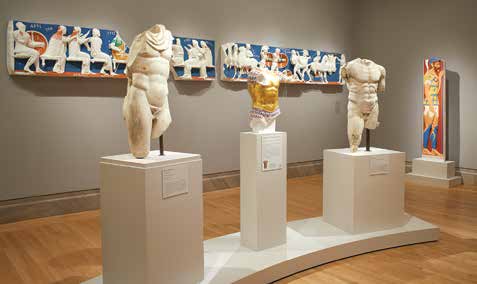
At the Legion of Honor through January 7, 2018
The Fine Arts Museums of San Francisco (FAMSF) is hosting Gods in Color: Polychromy in the Ancient World, an exhibition that presents ancient sculpture to Bay Area audiences as never before: in vibrant color. The exhibition reintroduces “polychromy”—the painting of sculpture to dazzling and powerful effect.
Defying the idea of the stark white marble of antiquity, the installation is the result of over 30 years of groundbreaking research in pigmentation of ancient sculpture by international scientists and archaeologists. On view at the Legion of Honor are nearly 40 reproductions of well-known Greek and Roman artworks painted in brightly colored authentic pigments, uniquely juxtaposed with 30 statues and carved reliefs from ancient Egypt, the Near East, Greece, and Rome from FAMSF’s’ own holdings, supplemented with magnificent loans from Californian and European collections.
“Our visitors who imagine the classical world as stark and white will be shocked and startled to see antique sculpture in such bright and vivid colors,” says Max Hollein, Director and CEO of the Fine Arts Museums of San Francisco. “Gods in Color explains how ancient art and architecture is incomplete without color. White or monochrome sculpture would have been as strange to the ancients as the color reproductions in this exhibition might seem to us.”

When the idea of classicism took hold during the Renaissance, artists like Michelangelo and other masters hailed form and composition, instead of color, as the most prominent and venerable features of ancient sculpture. Over time, knowledge of color in ancient sculpture became all but forgotten, and any evidence of polychromy was ignored. But even today, after millennia of burial and exposure to the elements, faint traces of color pigments on ancient sculptures can sometimes be detected with the naked eye.
Additionally, advances in technology and research have allowed for an understanding of the evolution and extent of ancient polychromy. Techniques such as ultraviolet fluorescence photography and the examination of ancient pigments via ultra-violet-visible (UV-VIS) absorption spectroscopy have allowed an international team of archaeologists and scholars to create astonishing color reproductions.
“This exhibition reveals the power of color to enliven art. It is a meeting of the oldest objects in our collection, some over four millennia old, with the latest, state-of-the-art technology,” explains Dr. Renée Dreyfus, curator in charge of ancient art and interpretation for FAMSF. “Through cutting-edge scientific investigation, ancient sculpture is brought back to its surprising splendor. This is a truly unique way to showcase FAMSF’s antiquity collection.”
This exhibition not only challenges the widely accepted ideal of achromatic ancient sculpture, but it also addresses how this misconception has influenced the history of sculpture. Works from ancient Greece and Rome are also joined by sculptures from Egypt and the Near East to reveal a fuller range of polychromy from across the ancient Mediterranean world.
Gods in Color: Polychromy in the Ancient World is the result of decades of research by Dr. Vinzenz Brinkmann and Ulrike Koch-Brinkmann together with a group of archaeologists and natural scientists. Brinkmann is the original curator of the traveling Gods in Color exhibition and is head of antiquities at the Liebieghaus Sculpture Collection in Frankfurt where he worked with Hollein during Hollein’s ten-year tenure as director of the Liebieghaus Sculpture Collection. The exhibition has traveled to some of the leading museums in the world, including the Vatican Museums, Rome; National Archaeological Museum, Athens; Pergamonmuseum, Berlin; Kunsthistorisches Museum, Vienna; and most recently to the Museo del Palacio de Bellas Artes, Mexico City. In San Francisco, it is being presented in its most recent version, based on new research and reproductions.
“Today, a viewer sees classical European art in museums, but in antiquity these sculptures were placed in temples, public squares and necropolises where color was critical for understanding or ‘reading’ these sculptures,” says Brinkmann. “We have been researching these phenomena for 35 years and have found a tremendous amount of traces of original colors. Our reproductions have created a very lively public debate worldwide.”
The exhibition is organized by FAMSF in collaboration with the Liebieghaus Sculpture Collection, Frankfurt. The curator of the exhibition is Dr. Renée Dreyfus, Curator in Charge of Ancient Art and Interpretation at FAMSF, in collaboration with Brinkmann.
For more information about this exhibit and others at the Legion of Honor, visit: https://legionofhonor.famsf.org/
Recent Comments